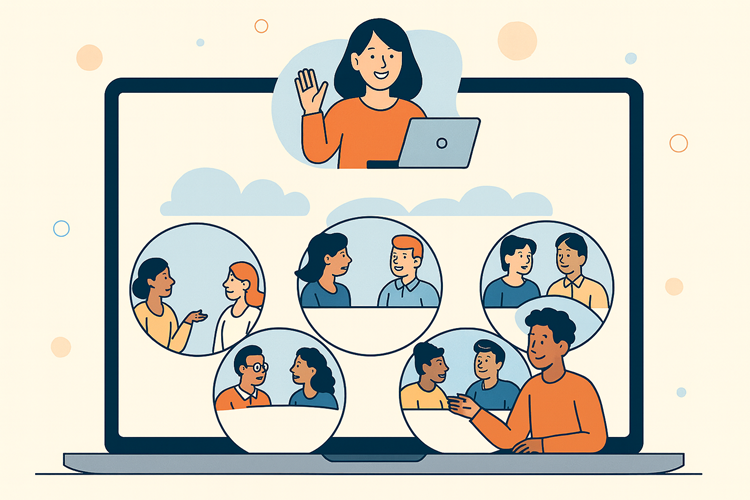Imagine twenty new employees joining in one month. Instead of long presentations, they rotate through five themed virtual rooms led by expert mentors. In every rotation, they connect with a completely different set of colleagues—so by the end, each new hire has met every mentor and built relationships with almost all their peers.
Why Traditional Onboarding Falls Short
Traditional onboarding often means hours of presentations, policy overviews, and one-way information dumps. New hires sit and listen, but rarely get the chance to ask questions, interact with leaders, or meet their peers in a meaningful way. The result? Employees walk away with information, but not with connections.

Of course, companies can (and should) keep the classic onboarding structure for compliance and essential training. But adding a dynamic layer—like themed mentor-led rotations—turns the process from passive learning into active engagement. Instead of only absorbing rules and procedures, employees also get to know the people behind the company and build relationships with their fellow newcomers.
The 5-Breakout Rooms Online Onboarding Model
For international teams—and really for any modern workforce—online onboarding is no longer a nice-to-have, it’s expected. Remote and hybrid employees want flexibility, yet they also need a way to connect with the company and with each other. The five breakout rooms model delivers both. Each room is led by a mentor covering a critical topic, while small rotating groups of new hires keep the sessions lively and personal. By the end, every employee has learned the essentials, met all five mentors, and built a network of colleagues across different countries and functions.
Here are some examples of breakout rooms that can turn onboarding from a static presentation into an interactive learning experience. Each room is led by a subject-matter expert who not only shares knowledge but also answers questions and engages small groups in discussion.
- HR & Workplace Policies – Led by an HR manager, this session covers benefits, vacation policies, diversity and inclusion programs, performance cycles, and how to navigate HR systems. Outcome: employees feel confident using HR processes and benefits from day one.
- IT & Cybersecurity – An IT security specialist guides new hires through logins, VPN, device setup, password policies, and how to spot phishing attempts. Outcome: secure system access and awareness of cyber risks.
- Health & Safety (EHS) – With the Environmental Health & Safety officer, participants learn about ergonomics (both remote and office), emergency procedures, and wellbeing resources. Outcome: employees know how to set up a healthy workspace and respond in emergencies.
- Compliance & Code of Conduct – A compliance officer or legal counsel explains data privacy, anti-corruption rules, reporting channels, and vendor ethics. Outcome: new hires understand company standards and how to escalate concerns.
- Culture & Values – A senior leader or culture ambassador introduces the company’s mission, values, and leadership principles, showing how they guide daily decision-making. Outcome: employees feel connected to the company story and culture.
How the Group Rotations Work
Think of the process as a form of corporate speed networking—inspired by the speed dating model. Instead of one long lecture, new hires move in small groups from room to room. Each mentor meets with four employees at a time, creating an interactive setting for questions and real conversation.

After each round, the groups reshuffle. That way, every employee not only meets each mentor exactly once but also sits with a completely different set of colleagues each time. By the end of the program, all 20 new employees have connected with all five mentors and almost the entire cohort. The result: onboarding that feels less like training and more like speed networking with a purpose.
The Role of the Host
Even with automated rotations, every onboarding event needs a “director” or host. This person opens the session, welcomes new employees, keeps the energy high during breaks, and makes sure everyone is present and engaged. While the platform manages the room rotations automatically, the host provides the human touch: checking in with participants, answering logistical questions, and stepping in if someone drops off or needs to be reassigned manually. Alongside the five mentors, the host is the glue that holds the entire experience together.
Ready to Bring This Model to Your Onboarding?
If this scenario sounds like the kind of onboarding experience your company needs, let’s build it together. In your first month, we’ll design and run the event side by side with you—so your new hires experience the full value of mentor-led rotations and peer networking right away. After that, you’ll have the tools and know-how to run future sessions on your own. It’s an investment that turns onboarding into an engaging, repeatable process that pays off from day one.